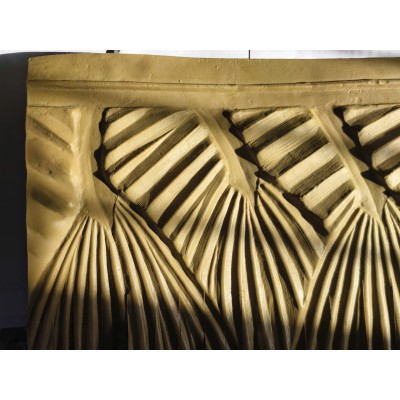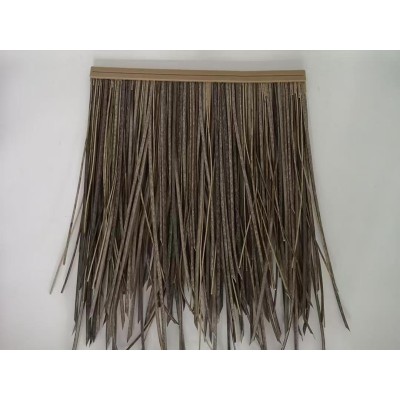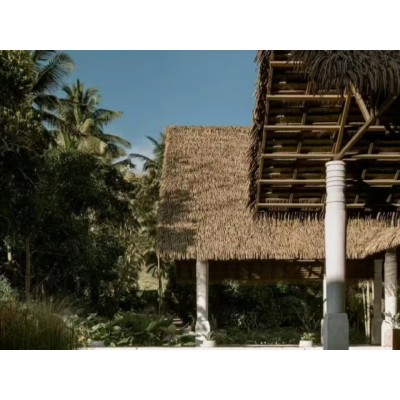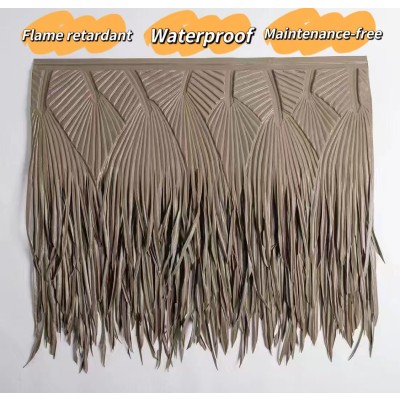Artificial reed thatch roofing is easier to install than natural reed thatch roofing materials. It is lightweight, flame retardant, maintenance-free, and can be customized in terms of size, color, texture, and more. We can assist with your artificial reed thatch roofing installation
1. Our faux bali thatch roofing for sale:
2. Features of plastic bali thatch roofing:
Material:
Nylon
Regular Size:
◭ 500x450mm
◭ Customize if the quantity is workable.
Quantity for 1 Square Meter Roof:
8-10 pieces are better.
Fireproof:
Available
Waterproof:
Need to install waterproof membrane on the bottom
3. Advantages of synthetic bali thatch materials:
◭ Good windproof performance, no threat and damage from insects, worms, birds and fungi;
◭ Strong adhesion, high toughness, strong impact resistance, smooth coating, strong pollution resistance, easy to clean;
◭ Beautiful: elegant color and rich color, realistic effect, long service life;
◭ Quick, flexible and convenient construction, not limited by roof shape and slope requirements;
◭ Light weight, conducive to structural design;
◭ No subsequent maintenance and replacement work;
◭ Environmental protection, recyclable
◭ Various colors, textures for options; more than 30 models for choice
Abstract: This paper focuses on the artificial waterproof reed thatch roof in Kenya. Through the research of its material characteristics, manufacturing process, waterproof principle and practical application effect, it aims to find out the artificial waterproof reed thatch roof scheme that is most suitable for the local environment and needs, and provide a reference for roofing solutions with both traditional characteristics and modern functions for the construction field. Contribute to the architectural development and cultural heritage of the Kenyan region.
I. Introduction
Kenya has a unique natural and human environment, and the traditional reed-thatched roof is an important symbol of local architectural culture. However, with the development of The Times, the requirements for roof waterproof performance are increasing day by day. How to give it excellent waterproof ability while retaining the characteristic appearance of reed thatch has become an urgent problem to be solved in the field of architecture. The artificial waterproof reed-thatch roof, which combines the charm of traditional materials with modern technology, is of great significance to the sustainable development of architecture in Kenya.
Ii. Overview of traditional reed-thatched roofs in Kenya
(1) Sources of materials
The rich reed resources in Kenya provide natural materials for traditional roofs. These reeds are mostly grown in wetlands around rivers and lakes, which have the advantages of convenient materials and low cost.
(2) Structural characteristics
The traditional reed thatch roof is laid layer by layer, with a gentle slope to adapt to local rainfall patterns, and uses gravity to drain water to a certain extent, but in extreme weather such as heavy rains, the waterproof effect is poor.
Third, the material innovation of artificial waterproof reed thatch roof
(A) reed treatment technology
By impregnating the special water repellent agent, the surface of reed fiber formed a hydrophobic layer to enhance its water repellent ability. For example, the use of silicone water repellent can penetrate deeply into the reed interior and form a microscopic protective film on the surface to prevent water intrusion.
(2) auxiliary waterproof materials
The addition of waterproof breathable film at the bottom of the thatch layer, such as polytetrafluoroethylene film, can not only prevent rain from penetrating into the house, but also let the moisture in the roof structure out, avoid internal moisture and mold, and extend the service life of the roof.
Fourth, manufacturing process optimization
(1) Improvement of weaving and fixing methods
Tighter, more complex weaving reduces gaps and reduces the risk of rainwater leakage. At the same time, the use of stainless steel wire or weatherproof rope to fix the thatch, compared with the traditional binding method, enhance the stability of the roof in windy weather.
(2) Modular assembly
The reed thatch is made into prefabricated modules, which can be quickly spliced on the construction site to improve construction efficiency, ensure the consistency of roof laying quality, and facilitate the maintenance and replacement of damaged modules in the later stage.
5. Waterproof performance test and evaluation
(1) Laboratory simulation test
Simulate the environmental conditions of different intensity rainfall, ultraviolet radiation and temperature change in Kenya, and test the waterproof and durability of the artificial waterproof reed thatch roof samples, and measure the key indicators such as water seepage rate and wind resistance.
(2) Actual construction application monitoring
Several buildings



